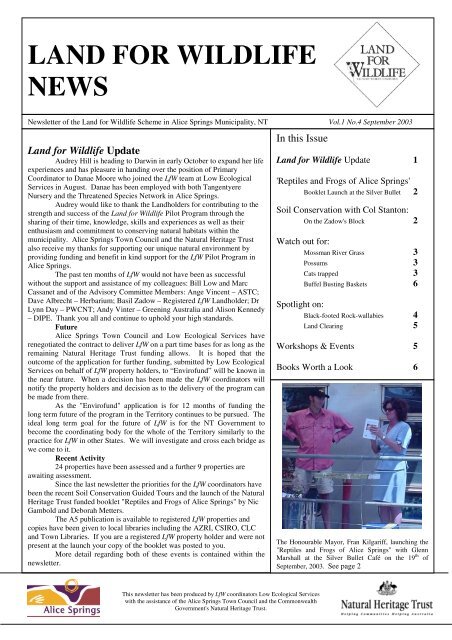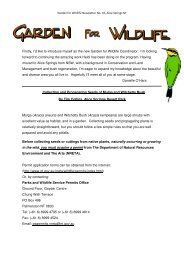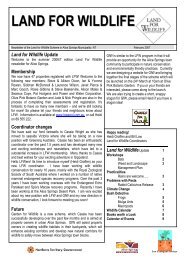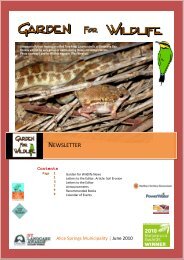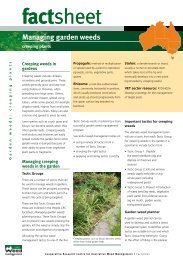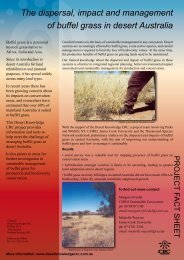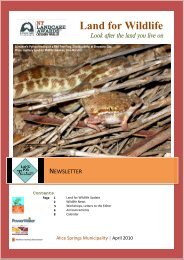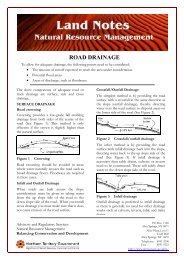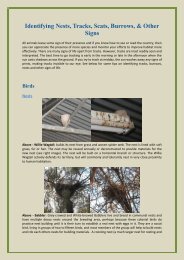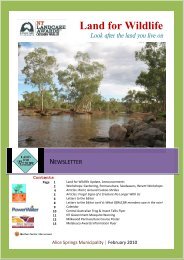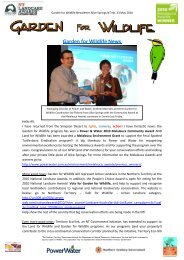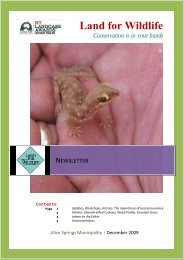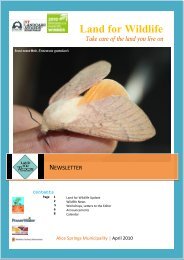LAND FOR WILDLIFE NEWS - Low Ecological Services
LAND FOR WILDLIFE NEWS - Low Ecological Services
LAND FOR WILDLIFE NEWS - Low Ecological Services
You also want an ePaper? Increase the reach of your titles
YUMPU automatically turns print PDFs into web optimized ePapers that Google loves.
<strong>LAND</strong> <strong>FOR</strong> <strong>WILDLIFE</strong><br />
<strong>NEWS</strong><br />
Newsletter of the Land for Wildlife Scheme in Alice Springs Municipality, NT Vol.1 No.4 September 2003<br />
Land for Wildlife Update<br />
Audrey Hill is heading to Darwin in early October to expand her life<br />
experiences and has pleasure in handing over the position of Primary<br />
Coordinator to Danae Moore who joined the LfW team at <strong>Low</strong> <strong>Ecological</strong><br />
<strong>Services</strong> in August. Danae has been employed with both Tangentyere<br />
Nursery and the Threatened Species Network in Alice Springs.<br />
Audrey would like to thank the Landholders for contributing to the<br />
strength and success of the Land for Wildlife Pilot Program through the<br />
sharing of their time, knowledge, skills and experiences as well as their<br />
enthusiasm and commitment to conserving natural habitats within the<br />
municipality. Alice Springs Town Council and the Natural Heritage Trust<br />
also receive my thanks for supporting our unique natural environment by<br />
providing funding and benefit in kind support for the LfW Pilot Program in<br />
Alice Springs.<br />
The past ten months of LfW would not have been as successful<br />
without the support and assistance of my colleagues: Bill <strong>Low</strong> and Marc<br />
Cassanet and of the Advisory Committee Members: Ange Vincent – ASTC;<br />
Dave Albrecht – Herbarium; Basil Zadow – Registered LfW Landholder; Dr<br />
Lynn Day – PWCNT; Andy Vinter – Greening Australia and Alison Kennedy<br />
– DIPE. Thank you all and continue to uphold your high standards.<br />
Future<br />
Alice Springs Town Council and <strong>Low</strong> <strong>Ecological</strong> <strong>Services</strong> have<br />
renegotiated the contract to deliver LfW on a part time bases for as long as the<br />
remaining Natural Heritage Trust funding allows. It is hoped that the<br />
outcome of the application for further funding, submitted by <strong>Low</strong> <strong>Ecological</strong><br />
<strong>Services</strong> on behalf of LfW property holders, to “Envirofund” will be known in<br />
the near future. When a decision has been made the LfW coordinators will<br />
notify the property holders and decision as to the delivery of the program can<br />
be made from there.<br />
As the "Envirofund" application is for 12 months of funding the<br />
Silver Bullet Complex RE-opening -4 th long term future of the program in the Territory continues to be pursued. The<br />
ideal long term goal for the future of LfW is for July the NT Government to<br />
become the coordinating body for the whole of the Territory similarly to the<br />
practice for LfW in other States. We will investigate and cross each bridge as<br />
we come to it.<br />
Recent Activity<br />
24 properties have been assessed and a further 9 properties are<br />
awaiting assessment.<br />
Since the last newsletter the priorities for the LfW coordinators have<br />
been the recent Soil Conservation Guided Tours and the launch of the Natural<br />
Heritage Trust funded booklet "Reptiles and Frogs of Alice Springs" by Nic<br />
Gambold and Deborah Metters.<br />
The A5 publication is available to registered LfW properties and<br />
copies have been given to local libraries including the AZRI, CSIRO, CLC<br />
and Town Libraries. If you are a registered LfW property holder and were not<br />
present at the launch your copy of the booklet was posted to you.<br />
More detail regarding both of these events is contained within the<br />
newsletter.<br />
In this Issue<br />
This newsletter has been produced by LfW coordinators <strong>Low</strong> <strong>Ecological</strong> <strong>Services</strong><br />
with the assistance of the Alice Springs Town Council and the Commonwealth<br />
Government's Natural Heritage Trust.<br />
Land for Wildlife Update 1<br />
'Reptiles and Frogs of Alice Springs'<br />
Booklet Launch at the Silver Bullet 2<br />
Soil Conservation with Col Stanton:<br />
On the Zadow's Block 2<br />
Watch out for:<br />
Mossman River Grass 3<br />
Possums 3<br />
Cats trapped 3<br />
Buffel Busting Baskets 6<br />
Spotlight on:<br />
Black-footed Rock-wallabies 4<br />
Land Clearing 5<br />
Workshops & Events 5<br />
Books Worth a Look 6<br />
The Honourable Mayor, Fran Kilgariff, launching the<br />
"Reptiles and Frogs of Alice Springs" with Glenn<br />
Marshall at the Silver Bullet Café on the 19 th of<br />
September, 2003. See page 2
The (A)boreal skink to (Z)ig-zag gecko<br />
of local Frogs and Reptiles<br />
On the 20 th of September a crowd of 35<br />
people gathered to celebrate the successful<br />
completion of a very special Land for Wildlife<br />
devolved grant (NHT funded) project; the<br />
release of the field guide: Reptiles and<br />
Frogs of Alice Springs.<br />
It was another bright and sunny Friday in<br />
Alice Springs that heralded the launch of a<br />
valuable new resource for Land for Wildlife<br />
members. Conceived by the Lilliecrapp Road LfW<br />
Group, former LfW Coordinator Deb Metters and<br />
reptile expert Nic Gambold, it took close to a year<br />
of hard work, dedication and a deep love of all<br />
things herpetological to produce the field guide:<br />
Reptiles and Frogs of Alice Springs.<br />
Previously, budding naturalists and LfW<br />
property owners tended to rely on the weighty<br />
Reptiles and Amphibians of Australia (Cogger)<br />
when wanting to identify some of the local fauna<br />
of the croaking or scaled kind. Though highly<br />
informative this book was never designed to fit in<br />
your back pocket. With the advent of Reptiles and<br />
Frogs of Alice Springs written and produced by<br />
Nic Gambold and Deb Metters and funded<br />
through the NHT assisted LfW devolved grant<br />
program LfW members now have a simple and<br />
easy to use pictorial reference to assist them in<br />
gaining a better understanding of the fauna<br />
inhabiting their properties.<br />
The launch was held at the Silver Bullet<br />
Café, which is itself located on a registered LfW<br />
property under the management of Mike Gillam<br />
and Maria Gaicon. Over 35 people including<br />
thirteen LfW property owners and a number of<br />
private business and government representatives<br />
took a break from their busy schedules to adjourn<br />
to the Silver Bullet for a delicious lunch and to<br />
find out about the new book.<br />
LfW Coordinator Audrey Hill opened the<br />
launch proceedings followed by speeches from<br />
both Nic and Deb who gave thanks to all those<br />
who contributed to the project. Glenn Marshall,<br />
Chairman of the Lilliecrapp Rd LfW group also<br />
gave a speech, thanking all LfW members for their<br />
valuable contribution to preserving the natural<br />
environments of the Alice Springs region. The<br />
Mayor, Fran Kilgariff, representing LfW sponsor<br />
Alice Springs Town Council, officially launched<br />
the Reptiles and Frogs of Alice Springs, presenting<br />
the first print run copy to Glenn Marshall. With<br />
thanks from LfW Coordinators Audrey Hill and<br />
Bill <strong>Low</strong> the launch was over and everyone settled<br />
in to peruse the guide and swap comments. Bill<br />
also thanked Audrey for her key role in<br />
coordinating the LfW program over the very<br />
successful last 10 months and wished her well in<br />
her new life adventure in Darwin.<br />
Free copies of the Reptiles and Frogs of<br />
Alice Springs were handed out to all registered<br />
LfW property owners and contributors to the book<br />
who were present at the launch, copies were<br />
posted to those who could not attend. However as<br />
the field guide was designed primarily as a tool for<br />
LfW members, it remains a rare item with a total<br />
of only 50 copies printed. For public reference,<br />
copies were lodged with the LfW Office (<strong>Low</strong><br />
<strong>Ecological</strong> <strong>Services</strong>), the Town Council Library,<br />
TSN, CLC and the libraries of CSIRO, AZRI and<br />
Centralian College.<br />
By now all registered LfW property<br />
owners should have received their copy of the<br />
field guide and both the authors and the LfW<br />
Coordinators hope that it has proven to be a useful<br />
and interesting tool in helping members to<br />
understand and appreciate the native fauna of the<br />
Alice Springs area. Future publication is being<br />
looked into of this already popular guide.<br />
________________________________________<br />
Soil Conservation with Col Stanton on<br />
the Zadow’s Block<br />
Sixteen people enjoyed the opportunity to<br />
be guided around Basil and Lyn Zadow's property<br />
to learn of the different soil conservation<br />
techniques employed there and the reasons for it.<br />
Having other environmental<br />
organisations on hand was also beneficial for<br />
fielding the questions about plants and animal<br />
habitat.<br />
Greening Australia, Threatened Species<br />
Network, Aust. Plant Society and Alice Springs<br />
Field Naturalists were kept busy in sporadic bursts<br />
with queries and identification of samples.<br />
The Zadow's property allowed attendees<br />
to view clear examples of successful rehabilitation<br />
techniques including the "whoaboy" across the<br />
driveway that reinstates the natural flow line of<br />
one of the properties creeks, rehabilitation of the<br />
old road that crosses the property so that the water<br />
runoff now flows down the slope and thoughtful<br />
creation of the rock drain that reduces erosion at<br />
the properties boundary with the road verge.<br />
Attendees also were given the<br />
opportunity to view examples of poorly managed<br />
run-off and as a result soil erosion problems. This<br />
was a good time to ask questions of the<br />
experienced as to what they would recommend.<br />
It was interesting to see how seemingly<br />
small changes in the grounds surface or the<br />
placement of a log in a drainage line can result in<br />
large redirection of the water flow.<br />
Deep thanks goes to both Lyn and Basil<br />
for opening their property to the public as well as<br />
their neighbours for doing the same and to Col<br />
Stanton for his laid back and practical presentation<br />
style.<br />
Land for Wildlife News, Alice Springs, NT. Vol. 1 No.4 September 2003. 2
Photo: Col Stanton leads participants up the<br />
neighbours' driveway during the Soil Conservation<br />
Guided Tours.<br />
________________________________________<br />
Watch Out For<br />
Mossman River Grass<br />
Mossman River grass, Cenchrus<br />
echinatus is a declared noxious weed that was<br />
possibly introduced to Queensland during the<br />
1860s gold rush period.<br />
Description<br />
It is an erect<br />
annual grass that forms<br />
loose tussocks that can<br />
be up to 90cm tall. It<br />
is similar to but distinct<br />
from Buffel Grass<br />
because of its large<br />
spiny seed-bearing<br />
burrs. These are pale<br />
brown to reddish in<br />
colour and arranged in<br />
dense cylindrical<br />
spikes, between 2 and<br />
10cm in length. The<br />
burrs inner bristles are<br />
broad, joined together<br />
for half to one third of<br />
their length, and have<br />
minute downward<br />
pointing barbs towards<br />
the tip (D. Albrecht<br />
and L. Rogersl, 1999).<br />
Habitat and<br />
Distribution<br />
The grass is a<br />
native of tropical America. Generally growing in<br />
moist sandy or other light soils along creek lines<br />
and floodouts, as well as in highly disturbed areas.<br />
It is now a troublesome rural and urban weed in<br />
Qld and the coast of northern NSW. It also occurs<br />
locally and around Darwin in the NT. In WA it is<br />
widespread in the West Kimberleys.<br />
Control<br />
As Mossman River grass is an aggressive<br />
annual pioneer plant, it is essential to prevent<br />
seeding. Seedlings can emerge from depths of 9cm<br />
in clay soils and 10cm in loams.<br />
Control before burrs appear can be by<br />
hand pulling, cutting below ground level, burning<br />
or spraying. However, with all of these methods,<br />
they are only effective on plants already present,<br />
therefore follow up is necessary as new germinates<br />
appear.<br />
References<br />
Auld B.A. and Medd R.W. (1987), WEEDS:<br />
An illustrated botanical guide to the weeds of Australia.<br />
Inkata Press. Melbourne, VIC.<br />
Albrecht D. and Rogers L. (1999), Weeds of<br />
the Tanami: A field guide to the environmental weeds of<br />
the Tanami region, Central Australia. Asprint Print<br />
Group, Alice Springs,NT.<br />
.Parsons W.T. and Cuthbertson E.G.. (1992).<br />
Noxious weeds of Australia. Inkata Press. Melbourne,<br />
VIC, Sydney, NSW.<br />
________________________________________<br />
Possum Search Guides<br />
The Threatened Species Network has<br />
recently compiled a guide to searching for<br />
brushtail possum sign in the arid zone.<br />
The common brushtail possum<br />
(Trichosurus vulpecula vulpecula) is anything but<br />
common in the arid zone, and has been listed as an<br />
endangered species in the NT.<br />
The guide contains photos of scats,<br />
scratch marks and tracks, information about<br />
preferred food plants and habitats, and also has a<br />
sightings datasheet for those of you keen to do<br />
some searching. Copies are available by email<br />
tsnnt@ozemail.com.au or printed copies can be<br />
supplied for a small cost.<br />
________________________________________<br />
Cats Trapped<br />
Since the LfW Ilparpa cat trapping<br />
program commenced, 16 cats have been caught.<br />
Currently there are seven traps out on<br />
properties leaving three available for anyone else<br />
who would like to reduce the pressure on our<br />
native fauna.<br />
At this time of year the reptiles are<br />
becoming active and likely to become the main<br />
component of a feral cat’s diet. Sue Ripley<br />
recently delivered chux clothes and sardines to the<br />
properties with traps as encouragement to people<br />
to set traps.<br />
If you are interested in borrowing one of<br />
these traps, please contact Sue on telephone: 8952<br />
5073.<br />
Land for Wildlife News, Alice Springs, NT. Vol. 1 No.4 September 2003. 3
Spotlight On<br />
Black-footed rock-wallabies – on the hop!<br />
Around Alice Springs we are very lucky<br />
to have healthy populations of the nationally<br />
threatened black-footed rock-wallaby (Peterogale<br />
lateralis lateralis). Although it is not at all<br />
uncommon to see mobs of wallabies on Spencer<br />
Hill or out at Simpson’s Gap, the story isn’t quite<br />
so rosy across the species’ range. The MacDonnell<br />
Ranges race of black-footed rock-wallaby was<br />
once common across rocky range country in<br />
northern SA, central WA and the southern NT - in<br />
fact when naturalist H.H. Finlayson first travelled<br />
through central Australia (1932-35) he reported<br />
that ‘… it was one of the commonest mammals …<br />
with swarming populations in many of the rocky<br />
outliers of the main ranges’. But by 1956<br />
Finlayson concluded that the black-footed rock<br />
wallaby was rare in the Northern Territory, and<br />
persisted only in a few scattered locations in the<br />
MacDonnell and Davenport Ranges and the<br />
drainage of the Sandover and Bundey Rivers.<br />
Rock-wallabies have become extinct in<br />
the wheatbelt and desert areas of WA, from most<br />
of northern SA, and more recently (post 1979) at<br />
Uluru-Kata Tjuta National Park and outlying<br />
range systems in the southern part of the Territory.<br />
The main cause of their decline appears to be fox<br />
predation, and a ten-year fox control program<br />
around wheatbelt populations of black-footed<br />
rock-wallabies showed dramatic recovery in<br />
populations where baiting was done. Cats, dingoes<br />
and wild dogs are also known to kill rockwallabies,<br />
but there have been no studies to show<br />
the relative impacts of these pressures. Habitat<br />
change due to unfavourable fire regimes or weed<br />
invasions are also likely to impact on rockwallaby<br />
survival.<br />
The onward march of buffel grass into<br />
range habitat around Alice is of considerable<br />
concern, and although there is some debate as to<br />
whether rock-wallabies might in some way<br />
actually benefit from the presence of buffel (it<br />
might possibly provide forage during dry times<br />
when other food plants are in low supply), it is<br />
clear that repetitive hot wildfires that potentially<br />
result from buffel invasion would have a very<br />
negative impact on biodiversity generally.<br />
There have been several projects<br />
focussing on collecting more data on rock-wallaby<br />
population in the region. Parks and Wildlife have<br />
rangers involved in monitoring populations at<br />
Parks in the West MacDonnell Ranges.<br />
Monitoring involves counting the numbers of<br />
fresh scats within a 1m 2 permanently marked area,<br />
or spotlighting and recording numbers of<br />
individuals along a permanent transect.<br />
The Centralian Land Management<br />
Association ran a project called “Rock-wallaby<br />
Watch” as part of the TSN community grants<br />
program, and collected data on rock-wallaby<br />
populations across pastoral lands in the southern<br />
NT. As a result of extensive searches for rockwallaby<br />
sign on ten pastoral stations where<br />
historic records of wallabies existed, or where<br />
suitable habitat was deemed to occur, CLMA<br />
concluded that rock-wallabies are surviving in<br />
good numbers in only a handful of locations on<br />
pastoral lands within the fox-line, and that<br />
populations are continuing to disappear from<br />
isolated hills and outlying ranges on the edges of<br />
their current distribution.<br />
Aboriginal people have been involved in<br />
rock-wallaby survey and predator control work<br />
funded through TSN community grants on<br />
Anangu-Pitjantjatjarra Lands (northern SA) and<br />
Ngaanyatjarra Lands (WA, around Warburton).<br />
Fox control is seen to be crucial in maintaining<br />
these very small colonies that are surviving in<br />
isolated spots within the Central Ranges system.<br />
Land for Wildlife members (or others)<br />
with rock-wallaby populations near by may be<br />
interested in setting up some ongoing monitoring<br />
sites to look at the impact of buffel grass on rockwallaby<br />
numbers and to see whether rockwallabies<br />
graze on buffel preferentially at any time<br />
of the year. The Threatened Species Network can<br />
help with the set up of these experiments, and<br />
would be keen to hear from anyone interested in<br />
dedicating some time to this activity. Please call<br />
Colleen O’Malley ph. 8952 1541 or email<br />
tsnnt@ozemail.com.au. . Sketch and text by<br />
Angela Gee/TSN.<br />
________________________________________<br />
Looking for Black-footed rock-wallaby Scats<br />
Rock-wallaby scats are roughly 2 cm<br />
long, black or grey in colour, cylindrical in cross<br />
section and tapering to a point. When broken,<br />
scats show coarse fragments of plant material.<br />
Euro scats, by comparison, are larger and cubeshaped,<br />
while similar looking possum scats are<br />
harder to break and have more finely digested<br />
plant material inside.<br />
Land for Wildlife News, Alice Springs, NT. Vol. 1 No.4 September 2003. 4
Photograph supplied by, A guide to rare and threatened<br />
animals in Central Australia.<br />
The above mentioned guide authored by<br />
Rachel Paltridge and Steve McAlpin is available<br />
to Land for Wildlife landholders at a discounted<br />
price. Copies are available through ALEC (Arid<br />
Lands Environment Centre). Refer to Land for<br />
Wildlife newsletter issue 1 for book review.<br />
__________________________________<br />
Land Clearing<br />
New Native Vegetation Clearing<br />
Controls apply to properties two hectares or<br />
greater in size where more than one hectare of<br />
Native Vegetation is wanted to be cleared. If one<br />
hectare of Native Vegetation has already been<br />
cleared from the property than a permit is required<br />
for further clearing. These permits apply to<br />
freehold and Crown land. Pastoral Leases will<br />
continue to operate under the Pastoral Land Act.<br />
Applications for a permit to clear native<br />
vegetation must be lodged on a prescribed<br />
application form. Application forms are available<br />
from the Department of Infrastructures, Planning<br />
and Environment and to cover the cost of<br />
processing, most applications will incur a fee of<br />
$120.00.<br />
The Native Vegetation Clearing Controls<br />
are covered by the Interim Development Control<br />
Order No. 12 under the Planning Act.<br />
Enforcement of these controls and prosecution are<br />
provided for under section 75 of the Planning Act.<br />
Contravening the Act could result in the maximum<br />
penalties of $20,000.00 for an individual or<br />
$100,000.00 for a corporation.<br />
For further information or application<br />
forms, contact Department of Infrastructures,<br />
Planning and Environment, 1 st floor, Alice Plaza,<br />
Todd Mall Alice Springs 8951 9245 or view the<br />
Land Clearing Guidelines on-line at:<br />
www.lpe.nt.gov.au/advis/land/clearing/default.htm<br />
________________________________________<br />
Workshops & Events<br />
2003 October<br />
1 st October, Wednesday<br />
Australian Plant Society - The meeting will be<br />
held at the Olive Pink Botanic Garden, 7.30pm.<br />
Peter Meech will demonstrate "Pruning of Native<br />
Plants".<br />
5 th October, Sunday<br />
Cool Communities House, Barclay<br />
Cresent. Open House Tour. Learn ways of<br />
making your every day living more sustainable.<br />
8 th October, Wednesday<br />
Alice Springs Field Naturalists Club -<br />
Meet in the staffroom of OLSH on Spearwood Rd,<br />
7.30pm. Joe Benshemesh will be making a<br />
presentation on Marsupial Moles<br />
Image supplied by Threatened<br />
Species Network, Alice<br />
Springs.<br />
10 th October, Friday 3.30pm<br />
Rangelands Seminar at CSIRO – Heath<br />
Road. Felicity Forth of Water Watch will<br />
present 6 years data on water quality in the Todd<br />
River.<br />
11 th & 12 th October, Saturday &<br />
Sunday<br />
Join the Field Naturalists in assisting<br />
with a fish survey at Fringe Lilly George. 4WD<br />
needed. This will be an overnight camp, but those<br />
who just want to help out for the day are welcome.<br />
Leoni Read, Public Officer for the Alice Springs<br />
Field Naturalist Club on 8952 1935.<br />
19 th October, Sunday<br />
WaterWatch. Join Rosalie Breen at<br />
Wigley's Waterhole for monitoring. Please<br />
contact Leoni Read, Public Officer for the Alice<br />
Springs Field Naturalist Club on 8952 1935.<br />
2003 November<br />
1 st November, Saturday, 9am-12pm<br />
Greening Australia Local Native<br />
Plants Sale - Bushcare Nursery, the Centrailian<br />
College (Grevillea Drive, Sadadeen).<br />
Enhance biodiversity and reduce water<br />
consumption by planting with local native species.<br />
5 th November, Wednesday<br />
Australian Plant Society - The meeting<br />
will be held at the Olive Pink Botanic Garden,<br />
7.30pm. Topic will be "Pests on Native Plants",<br />
presented by Geoff Miers.<br />
12 th November, Wednesday<br />
Alice Springs Field Naturalists Club -<br />
Meet in the staffroom of OLSH on Spearwood Rd,<br />
7.30pm. Jose Petrick will be giving us an insight<br />
to Egypt.<br />
2004<br />
July 5 th to 9 th , 2004. The 13 th Australian<br />
Rangelands Society Biennial Conference will be<br />
held at Minamurra Hall, St. Phillips College in<br />
Alice Springs. For more information contact LfW<br />
coordinator Bill <strong>Low</strong> or Dionne Walsh at CLMA<br />
on Leichhardt Tce, telephone: 8953 4230.<br />
Land for Wildlife News, Alice Springs, NT. Vol. 1 No.4 September 2003. 5
Buffel Busting Baskets<br />
During 2001, Alex Nelson suggested to<br />
me that Buffel Grass could be used in basket<br />
making. At that time I had thought about some of<br />
the European traditional methods of weaving for<br />
which Buffel would be too brittle. However, Alex<br />
was correct.<br />
Recently, Sonia Bazzacco, displayed<br />
baskets that she had created using Buffel and<br />
twine. This style of basket making is based on the<br />
method used by indigenous women.<br />
By winding the twine around rows of<br />
Buffel it is possible to bind together a strong and<br />
decorative basket. Other fibres can be employed<br />
in place of twine such as wool or strips of fabric.<br />
Have you come across any innovative<br />
ways of utilising the Buffel fuel load? If so,<br />
please share it with us by phoning 8955 5222.<br />
__________________________________<br />
Books worth a look<br />
Reptiles and Frogs of Alice Springs – A<br />
pictorial field guide to the reptiles and frogs of the<br />
Alice Springs district, Northern Territory, by Nic<br />
Gambold and Deborah Metters.<br />
This publication came about due to the<br />
Natural Heritage Trust's Devolved Grants and a<br />
successful application from the Lilliecrapp Road<br />
Land for Wildlife Group.<br />
With this warm weather about us, this<br />
booklet should be kept within easy reach because,<br />
" …This booklet aims to assist landholders and<br />
interested individuals in the basic identification of<br />
reptiles and frogs that may occur in and around<br />
Alice Springs. Every reptile and frog known to<br />
occur within a 50 kilometres radius of Alice<br />
Springs has been included, based on confirmed<br />
records from the Parks and Wildlife Commission<br />
NT Fauna Atlas for the Alice Springs municipality<br />
and personal observations by Nic Gambold, Greg<br />
Fyfe, Peter Comber, Steve McAlpin and Mike<br />
Gillam. Habitat and dietary preferences are<br />
discussed to assist landholders in identifying and<br />
protecting micro-habitats that may occur on<br />
private properties…."<br />
Weeds of the Tanami – A field guide to<br />
the environmental weeds of the Tanami region,<br />
Central Australia<br />
An A5 booklet prepared by Newmont<br />
Australia (Mining Company) in cooperation with<br />
the Alice Springs Herbarium to help people<br />
identify and stop the spread of weeds in the<br />
Tanami. Having written that, the species<br />
contained within this publication are also relevant<br />
to Alice Springs.<br />
There are high quality photographs,<br />
detailed descriptions, including notes on species<br />
reproductive cycles and modes of dispersal.<br />
Newmont Australia kindly donated 17 of<br />
the remaining copies to the Land for Wildlife<br />
program. As this is now out of print, please call<br />
the office (ph: 8955 5222) to request your copy.<br />
First come first served.<br />
Environment Online is now live!<br />
www.environment.org.au<br />
This innovative and exciting new<br />
website, Environment Online is the initiative of<br />
about 20 of the major environmental advocacy<br />
organisations in the Australian environment<br />
movement. These groups together constitute a<br />
Forum known as the Mittagong Forum.<br />
The Mittagong Forum, together with<br />
Social Change Online has conceptualised and<br />
developed this site that will be of interest and use<br />
for wide range of people, including fellow<br />
conservationists, environmentalists and activists,<br />
government, business people, and all those people<br />
in the community who are concerned about the<br />
natural world we live in.<br />
Click onto this site when you are next<br />
online and provide us with some feedback.<br />
________________________________________<br />
WILDCARE WILDCARE ALICE ALICE SPRINGS<br />
SPRINGS<br />
WILDCARE WILDCARE is a non-profit organization of<br />
volunteers providing a support network for carers<br />
of sick, injured and orphaned wildlife with the<br />
objective to rehabilitate and release them back into<br />
their natural habitat.<br />
Wildcare Wildcare members are provided with -<br />
o “hands on” training and are encouraged to<br />
participate in training courses and talks about<br />
the principals of caring, handling,<br />
rehabilitation and release of native birds and<br />
mammals;<br />
o Subsidised foods and specialised equipment;<br />
o Access to medical supplies and veterinarian<br />
advice.<br />
All Carers must have a current Rescue Permit<br />
issued by Parks and Wildlife. You can obtain<br />
your permit or become a member by contacting:<br />
Wildcare Wildcare Inc Inc, Inc at PO Box 1752, Alice Springs<br />
NT 0871 or telephone 0419 22 11 28.<br />
Land for Wildlife News, Alice Springs, NT. Vol. 1 No.4 September 2003. 6


